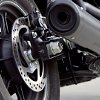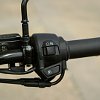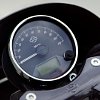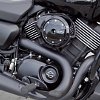It’s not often the Common Tread staff gets to type “new” and “Harley” next to each other, but I got to hear CT’s Video Commander say, “Lemmy, can you review the new Harley?” (Emphasis mine.)
New Harley? You betcha. Gimme the keys.
The Street 500 and 750 are new-new, not “here’s the same drivetrain with updated paint and tank badges” new. Look, long model runs are fantastic, but when a staid, conservative company like Harley releases something totally fresh, I’m drawn in like a moth to a flame. Due to their uncharacteristic release at EICMA in 2014, I had a brief hit of pre-winter joy when I learnt about the new Street series of motorcycles.
The Milan release is in keeping with the Street’s whole theme: This is different type of bike for a different type of customer. Harley execs aren't foolish. They understand that selling bikes to the world (population seven billion) is likely to be more profitable than selling bikes to the United States (population 318 million). However, over a century of selling to America has spawned bikes that perform admirably in many parts of this country and appeal to our tastes and preferences, but do not necessarily appeal to people on other parts of this globe who have different needs and tastes. Americans might look to Sturgis for new cruiser news, but when the whole world wants to see what’s next, it’s happening in Italy (EICMA) or Germany (Intermot).

The bike
The Street 750 may as well have been called the Mule. It’s meant to take beating and abuse — as most commuting, function-first bikes do — all in the name of planting the bar and shield in the minds of riders who still think you meet the nicest people on a Honda. Riders ripping through a metro area face most of the same obstacles someone in a country with poor transportation infrastructure does: awfully maintained road surfaces, lawless drivers with little care for their surroundings, and unbearable traffic. Hence, Harley built a bike that’s going to perform in both spots. The Streets (the 750 and the 500) are sturdy items that focus not on brute horsepower, but on longevity, handling, and maneuverability. The Street 750 gets a bump in bore size from the 500cc model. Other than that, the only differences between the two are the color of the cooling fins on the engine and the price.

It’s probably also worth noting that Streets are built in two countries. Bikes intended for domestic sale will be built in Harley’s Kansas City, Mo., plant. Bikes for international customers will be built overseas in Bawal, India. The Street models are notable because they are the first complete motorcycles Harley will sell that are manufactured completely outside the U.S.A.
The 60-degree, wet-sump, liquid-cooled V-twin nestled in the Street’s frame is a far cry from Harley’s usual colossally tall, 45-degree, dry-sump, air-cooled lumps. The shorter engine allowed engineers freedom with respect to the architecture of the bike. Due to this, the Street boasts both great suspension travel (3.5 inches in the front and 5.5 inches in the rear) and a low seat height (a hair over 28 inches). Plenty of traditional Harley-Davidsons sacrificed suspension travel for a lower seat.
That engine feeds its power into a six-speed transmission, which in turns spins the rear wheel with a belt, just like all modern Harley products.
The bike’s got a single disc on each wheel, squeezed by two-pot floating calipers. front and rear. They are biased unbelievably strangely — more on that in a bit. Relatively narrow tires — 100/80R-17 up front and 140/75R-15 in the rear — contribute to point-and-shoot handling.
In the United States, MSRP for the Street 750 is $7,499. Other than the 500 cc version, this is the least expensive bike Harley sells. That's $750 less than the base model Sportster, which has a poorer showing on the spec sheet than the Street.
Despite the focus on making the Street functional, Harley did not forget that sex still sells motorcycles. The Street 750 is drenched in black and comes with currently stylish fork gaiters and a bikini fairing.
Here’s one way to look at it: I know you’ve got a buddy who refuses to start on a "beginner" motorcycle because they’re so godawful bland. The Street is the zippy alternative. It’s like… medium salsa. Lava Volcano is just going to hurt going down, but nobody likes to ask a cute server for something called “mild.”

Testing the Street
I jumped onto this pint-sized, 749 cc terror with an open mind, fully aware that I am not the guy H-D expects to ride this. I put 1,000 miles on this bike. As crotchety as I am, this was way less of a chore than I initially expected it to be. I rode my absurdly long commuting miles, but I also slogged through many hours of city traffic. Not miles. Hours. I jumped curbs, ran over stuff, and dumped the clutch in order to catch post-stop-sign rubber more times than I could count.
The bike is very compact, super-approachable, and is built the way you’d expect a city bike to be built: simple, sturdy, and small(ish). Our test unit came to us with a set of crash bars and a six-pack-rack/sissy bar combo. These are optional Harley-Davidson accessories. I was ambivalent about the crash bars, but the six-pack-rack proved to be useful for transporting small items.

Street 750 highlights
Imagine how shocked I was to enjoy the motor. It’s not exactly the same architecture as a V-Rod, but it’s not far off, either. The Street is punchy and fun. The power delivery is almost as linear as that of a parallel twin. It’s gutsy and has great response. Even though I’m a far larger fella than most people who’d ride this, it still charged right along. There’s no tach on the bike, but unlike Harley’s previous small-bike offering — the Buell Blast — you don’t hit a rev-limiter until you’re obviously spinning the powerplant way too fast. It really was an eager engine. I pounded it, ran it hard and fast on the freeway, let it sit and cook at many city intersections, and the motor never flinched. H-D nailed this part of the bike.

The handling also put a grin on my face. The bike was quick and flick-y, especially considering the 32-degree rake angle. The Street’s 60.4” wheelbase — four inches shorter than a Big Twin — means the Street darts immediately where it’s pointed. The fairly flat, wide handlebars require a minimum of coaxing to get the bike headed where you want. No one will mistake this for CBR-like handling, but for a bike that’s designed to look and feel like a laid-back cruisin’ bike, the Street is a ballerina compared to some of the other barges on the market.

The Michelin Scorcher tires are rapidly becoming a favorite of mine. I think they could be one of the best OEM tires I have used. RevZilla Product Specialist Ed Wildman has been riding for a long time, and I think he summed it up well: “You don’t even notice or think about the tires.” For a factory tire, I think that’s about the highest praise that could be given. The narrow sizes help keep the handling nimble.

This little Piglet is easy on your wallet after you buy it, too. This bike ekes out about 130 miles out of a 3.5-gallon tank of fuel, which is pretty dang good. I saw 42-47 mpg as the norm, despite my merciless throttle hand. Not too shabby for a bike that has absolutely no problem with highway duty.
Street 750 lowlights
H-D’s Street 750's low price tag doesn’t leave lots of room for excess frippery and details. I have a short list of things that rubbed me all wrong. The most important is the brakes.
I mentioned earlier that the brakes are wonky. To be more specific, the back brake is super-strong, but the front is a mush-fest. I was unable to lock the front brakes under 40 mph. I crushed the lever right to the bar in my big old ham-fist, and it would… not… lock. Inappropriate. I’m not sure who spec’d these pieces, but I would have given up the fairing or fork gaiters or some other frippery to get more stopping power.
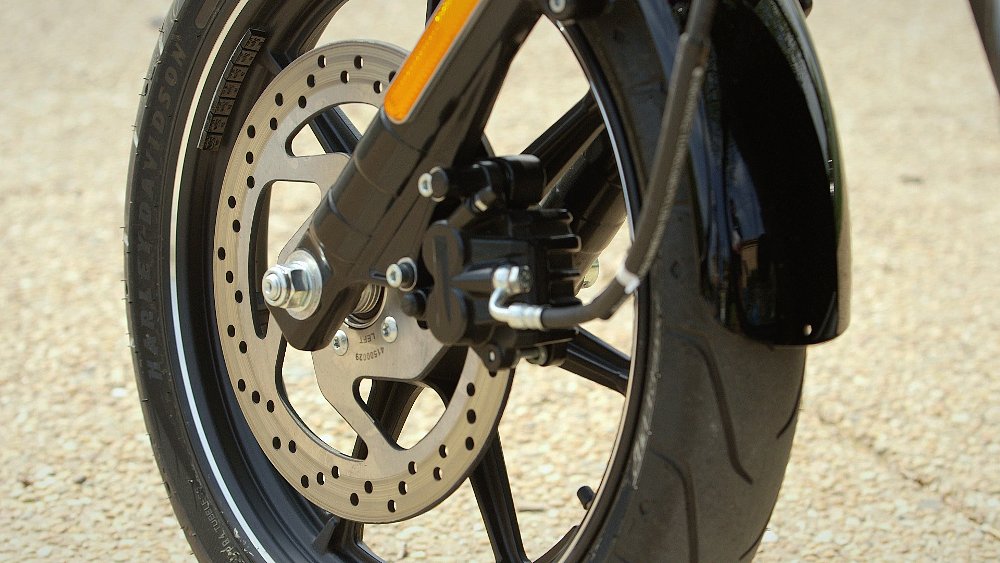
Speaking of that fairing, it bugs me that on the non-black models the fairing is not painted to match the tins. It looks like the amateur home jobs you see when someone is too cheap to pay to spray. Another minor annoyance that got me more comments than the bike's look was how often I left the light on. For some unbeknownst reason, the lock cylinder allows you to remove the key in the “accessory” position. I am accustomed to just turning the key until it stops, yanking it out, and going on my merry way. If you don’t pay attention, you’ll be pop-starting and buying batteries frequently.
OK, so those are minor annoyances. A much more aggravating trait of the Street I rode was its tendency to miss shifts. The 1-2 shift was miserable. I could not change my shifting style to suit this transmission. Hard, soft, fast, slow — nothing worked to get it to shift consistently. I experienced vague gear changes in other gears, too. The crashbox crapshoot with even the slightest bit of hard acceleration was annoying in all gears, but it happened most frequently from 1-2. It’s especially egregious because first is the gear everyone romps on, being that it usually does not get one arrested.
The linkage didn’t feel sloppy. I am hoping an oil change could cure most of this, but this was probably the item of biggest concern to me because rectifying it is likely to be labor-intensive. Who wants to split cases on a new bike?!

Another thing that was a little odd was how this bike lets you know it needs gas. It’s fuel-injected, so there’s no petcock, and thus no reserve. There is also no fuel gauge. There is, however, a teeny little light on the dash. Sadly, I ran this bike plumb out of gas. On one of my tanks of fuel, I got 17.3 miles of warning and was literally sucking wind. The bike was bucking as I pulled in for fuel. (Fortunately, Dee McB, a fellow Zillan, was with me and had a fuel bottle handy.)
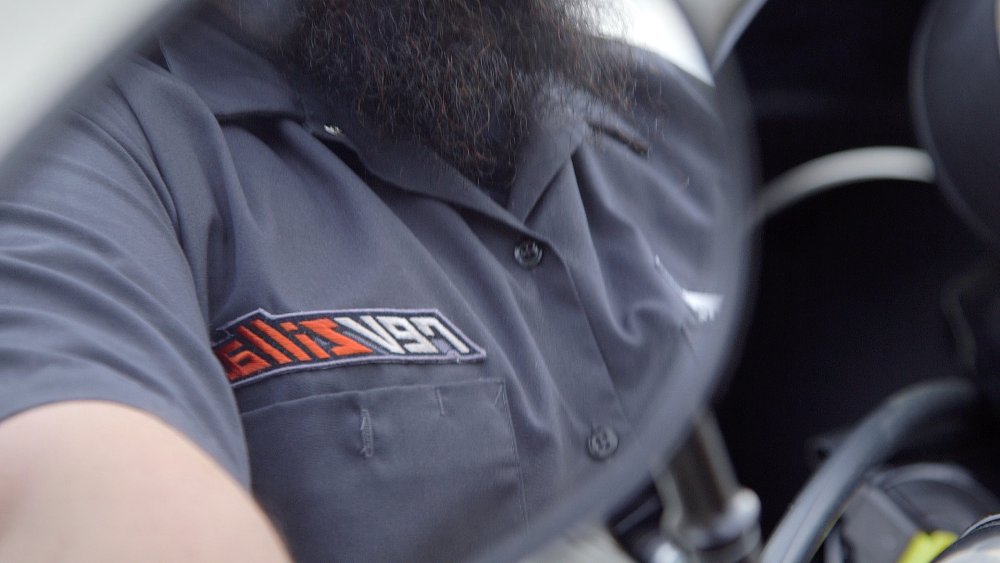
The mirrors also sucked terribly. Who cares? They are mirrors. They’re cheap and easy to replace. This is minor in my book. I expect a few budget items on a budget bike, and potential buyers who are realistic should, too.
The competition
You could be looking at a Street for a variety of reasons. If you want an entry-level H-D, you could say it competes against the Sporty or the Street 500, the steps up and down from the three-quarter-liter Street. Really, though, this bike faces two direct competitors outside the Motor Company’s offerings: The Kawasaki Vulcan S and the Honda Shadow series.
The Shadow has fewer ponies, a rear drum brake, and only five speeds. Like the Street 750, the Shadow has a liquid-cooled V-twin, of similar displacement. The Vulcan S makes a bit more horsepower, and has some ergonomic adjustment the Street lacks. You can also choose to upgrade to an ABS model. The base model is also a bit less money. However, the engine is a parallel-twin, not a V-twin, and it’s missing one thing that carries a lot of weight for many buyers: There is no bar and shield on the tank. The Street may not be as polished as the competitors, but it’s no slouch, either.

Conclusion
I’ll not mince words: this motorcycle is not better than its competition. However, it is a Harley that is faster than its bigger siblings, sounds terrifying with some exhaust work, and should leave most people with a monthly bike payment that is less than their grocery bill.
It’s nimble without being delicate and it's not overly expensive. That should make it successful in other parts of the world, where it will be bought by people with a wide variety of riding environments, some of them very different from North America. At home, a new crop of H-D customers will buy a Harley earlier in life than the previous generation. This mediocre bike will bring different people into the showrooms, where Harley has an opportunity to woo brand-new customers with service and wares. In that sense, the Street is perfect.





